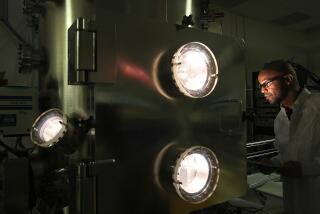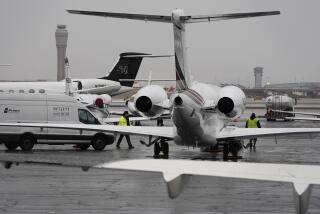Clinton Trying to Give a Lift to U.S. Civil Aircraft Industry
- Share via
WASHINGTON — President Clinton and his technology guru, Vice President Al Gore, are trying to put the aeronautics back into the National Aeronautics and Space Administration.
The primary goal is to bolster American civil aircraft manufacturing, one of the few domestic industries that still produces a positive trade balance.
“We’ll make planes lighter and reduce the time it takes to build them,” NASA Administrator Daniel S. Goldin vowed in a recent address to the National Aviation Club.
“We will provide better displays for the pilot, and (will produce) general aviation aircraft that are about as easy to fly as a car is to drive. We will design planes that can hop across the Pacific Basin twice a day, round trip. (And) we will literally learn to fly from the skies to the stars.”
U.S. aircraft manufacturers have seen their world market share erode at an alarming rate. In 1969, they built 91% of the civil aircraft sold worldwide. Today, the industry is struggling to maintain a 67% market share.
While the Republican administrations of Ronald Reagan and George Bush focused on big ticket space projects like space station Freedom and a manned mission to Mars, they overlooked the basic research needs of American civil aircraft manufacturers, said Bradford E. Biegon of the American Assn. of Aeronautics and Astronautics.
“The job base is declining, we’re facing increased economic competition on all fronts and this remains one of the few industries in which we’re economically competitive,” Biegon said. “We need to continue to make these research investments if we’re going to preserve this industry.”
To spur the effort, the White House budget submitted to Congress earlier this year calls for a dramatic increase in research funds that one day may make American-built passenger planes faster, safer and cheaper to operate.
Specifically, the Administration wants to spend more than $1 billion in the 1994 fiscal year on aeronautics research and development, up 18% from the current year. If Clinton and Gore have their way, the NASA aeronautics research budget will increase 50% by fiscal 1998.
The money will pay for research on subjects as diverse as wing icing, air traffic control systems, fuel efficiency, wind shear, cockpit design and jet pollution.
The centerpiece of the revved up research effort is a three-year-old program to develop an environmentally friendly, fuel efficient, lightweight passenger aircraft that would fly at more than twice the speed of sound, but offer fares comparable to current first class prices.
The goal would be to produce a plane that can be commercially manufactured by the year 2005 that would accommodate up to three times as many passengers as the existing supersonic Concorde, at roughly one-ninth of the cost per passenger mile.
If Clinton gets his way, funding for the high-speed civil transport program will rise next year by 60%, to $187 million. Studies cited by NASA conclude that the world market would support up to 1,000 such aircraft by the early 21st Century, creating a new, $15-billion-a-year revenue stream for domestic aircraft manufacturers. That business alone would generate 140,000 aerospace jobs.
In a sense, Clinton and Gore are trying to bring NASA back to its roots. What is now the U.S. space agency began in 1915 as NACA--the National Advisory Committee for Aeronautics.
The name was changed to the National Aeronautics and Space Administration in 1958, after the launching of the Soviet Union’s Sputnik, the first artificial satellite.
The high speed research program already is paying dividends to the beleaguered aerospace industry. McDonnell Douglas Aerospace’s Long Beach facility recently won a $23.9-million contract for work on the project, while Lockheed Corp.’s aeronautical systems unit in Georgia was awarded work worth $27.3 million.
More to Read
Inside the business of entertainment
The Wide Shot brings you news, analysis and insights on everything from streaming wars to production — and what it all means for the future.
You may occasionally receive promotional content from the Los Angeles Times.










